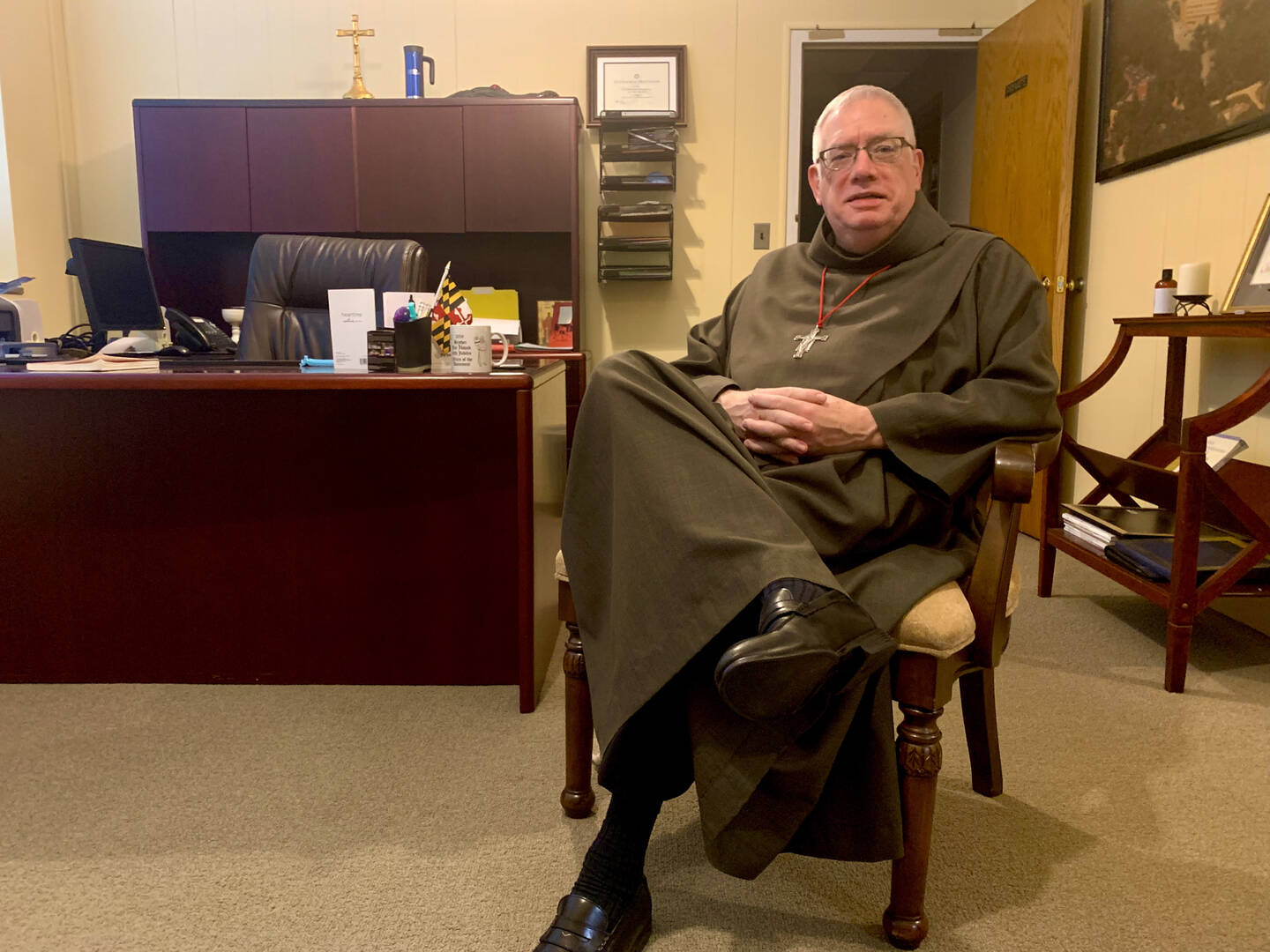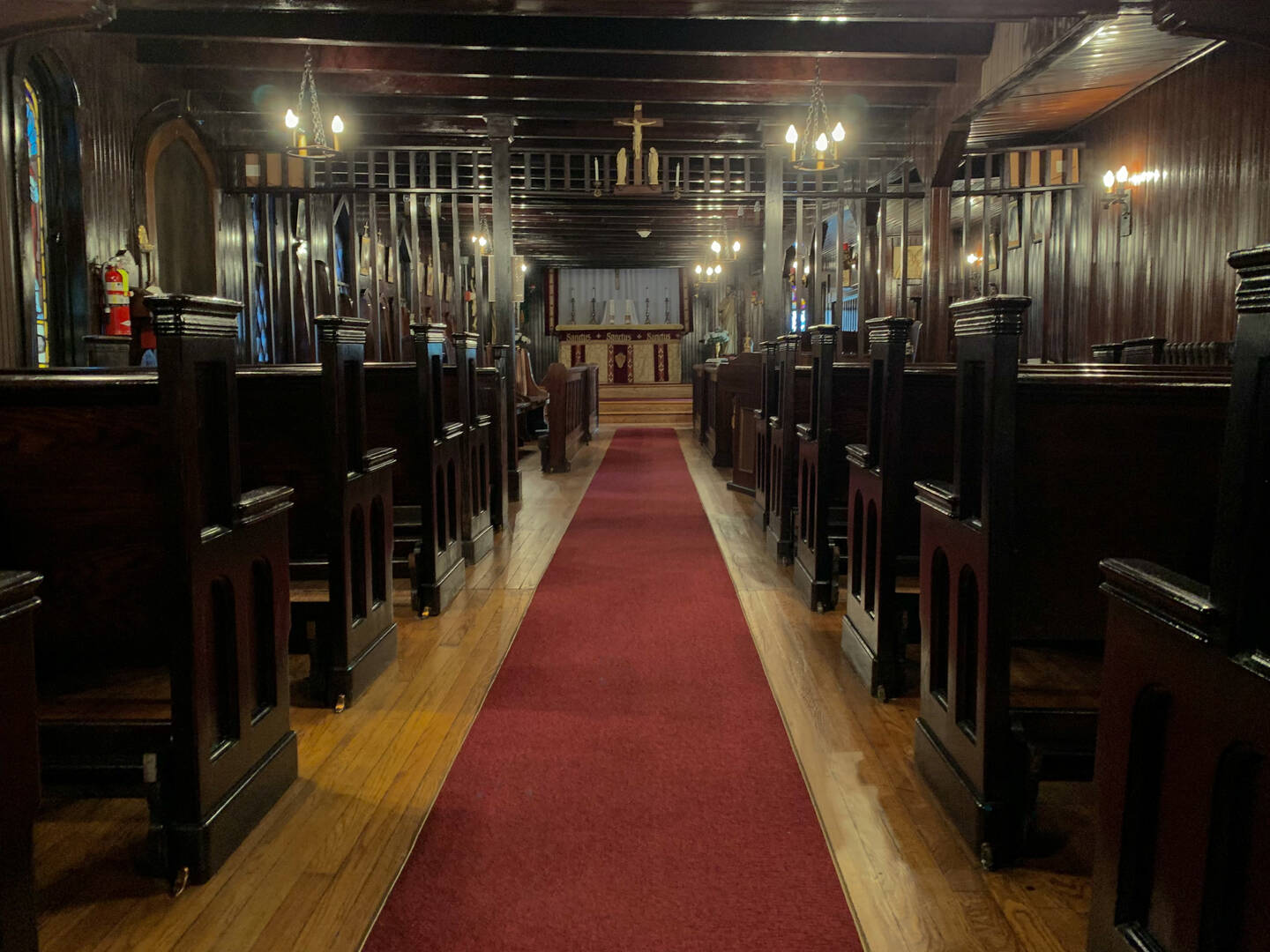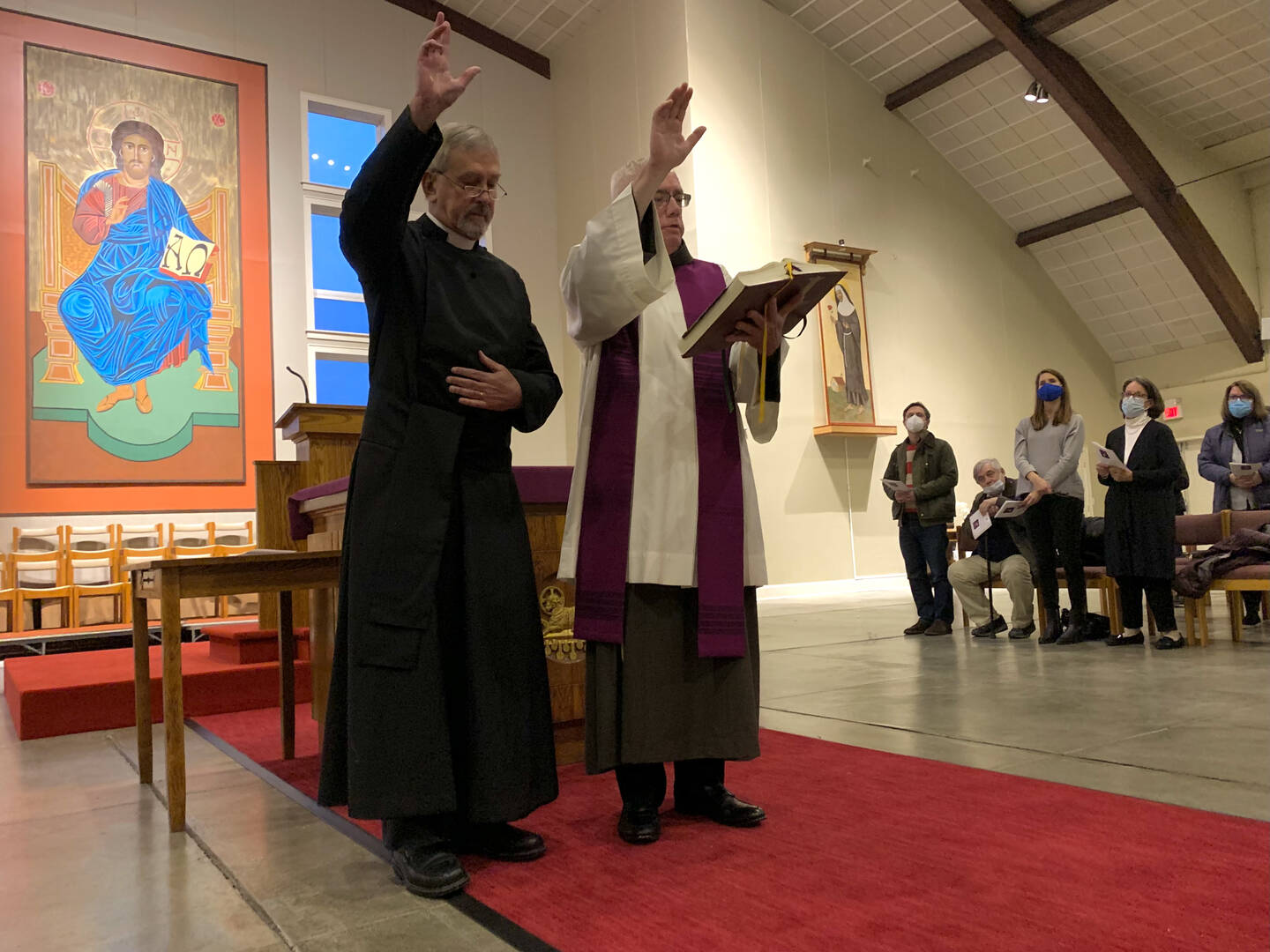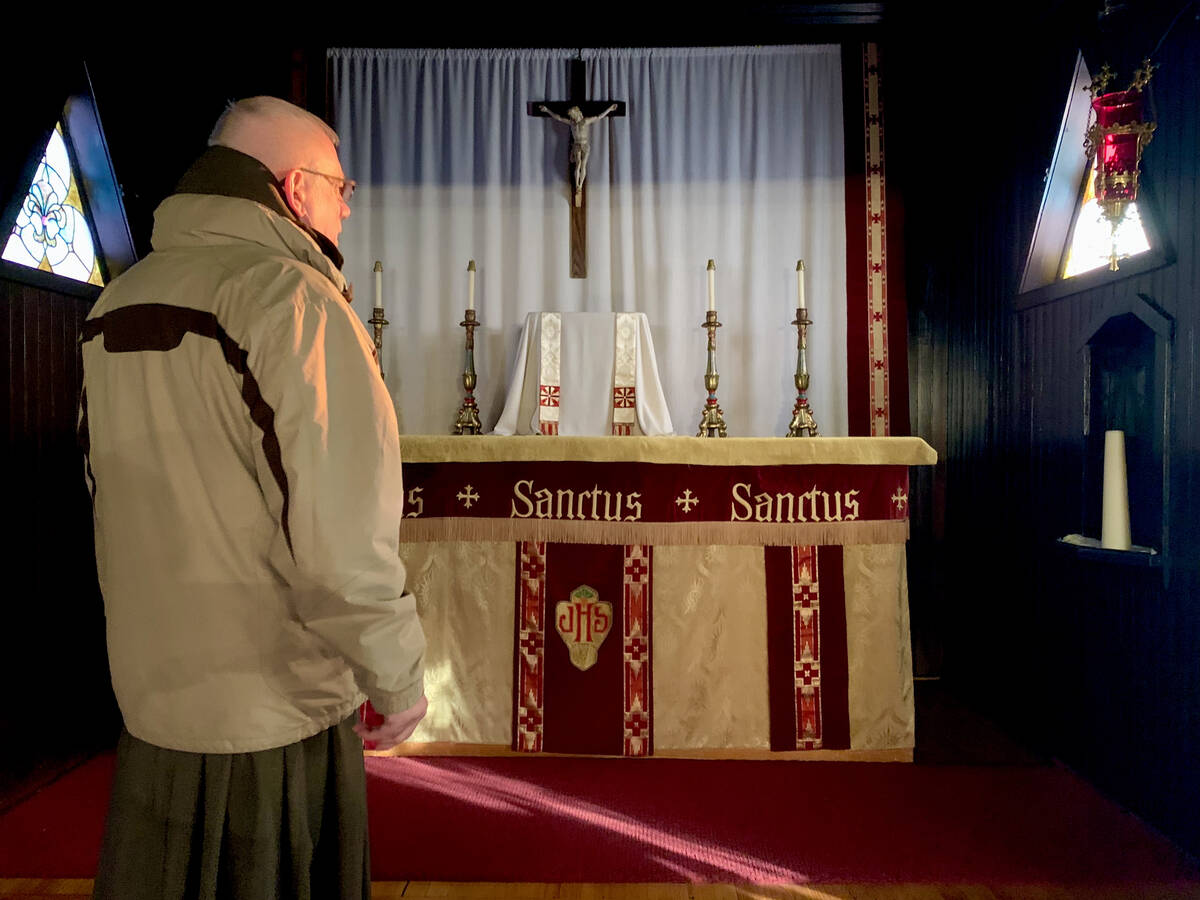It is a chilly evening on the First Sunday of Advent, and I am sitting inside a huge, warehouse-like building with a massive arched roof. Although some of the friars jokingly refer to it as the “cozy little airplane hangar,” it is, in fact, a chapel. I am visiting Graymoor, a small hamlet 50 miles or so north of New York City just across the Hudson River from West Point. It is here that the Society of the Atonement—the name used for both the Friars of the Atonement and the Sisters of the Atonement, two distinct orders of Franciscans dedicated to reconciling the various Christian denominations to one other—has its motherhouses. The name reflects the men’s and women’s shared history and charism.
Earlier this morning was the first snow of the winter season on top of the Holy Mountain, where the friary is located. As I sit in Our Lady of the Atonement Chapel in the evening, waiting for an ecumenical Advent service to begin, the brisk air from outside makes its best effort to infiltrate the cavernous place of worship. The altar is simple enough, a wooden construction without much decoration. Ten yards behind the altar, in between two windows on the wall, looms a massive iconographic portrait of Christ, sitting in glory and holding a book open with the Greek letters alpha and omega written on the two pages.
Over the course of a half hour, around 65 people, most of them middle-aged or older, make their way to seats that face each other on either side of the central aisle, huddled in jackets of various puffiness. A plush red carpet, extending from the chapel entrance to the altar, is the only thing covering the smooth, cold concrete floor.
The intermingling of Catholics and Episcopalians is par for the course at Graymoor.
The presider at the service is James Loughran, S.A., the vicar general of the Friars of the Atonement, although in our conversations he asked me to call him just Father Jim.
The wide reach of the Society of the Atonement includes hosting academic conferences on Christian unity and publishing the journal Ecumenical Trends—all of which is done through the Graymoor Ecumenical and Interreligious Institute, one of its ministries, which Father Loughran directs. The friars also operate the Centro Pro Unione in Rome, home to the largest collection of books on ecumenical topics in all of Europe. They also organize smaller events, like this Advent prayer service. But the most visible manifestation of this ecumenical activity is the Week of Prayer for Christian Unity, which the Society of the Atonement first started as an eight-day octave of prayer in 1908.
Joining Father Loughran on the altar is the Rev. Steven Schunk of the nearby St. Mary Episcopal Church, and while the Rev. Amanda Eiman of St. Philip Episcopal Church is not able to concelebrate as originally planned, she sits amid the congregation, one of her newborn twins in tow. While relatively few Catholics ever see members of the Episcopal clergy visiting their parishes, the intermingling of Catholics and Episcopalians is par for the course at Graymoor.
Torn Asunder
In the Gospel of John, Jesus, before his Passion, prays to the Father for the unity of his disciples, “that they may be one” (17:21). Yet today, there are tens of thousands of Christian denominations splintered from one another. How did we end up here?
“Error and sin.” These two words, Father Loughran says, summarize why Christians are no longer united.
It is a daunting question, but Father Loughran has a simple answer: “Error and sin.” These two words, he says, summarize why Christians are no longer united.
Father Loughran says Christians have been so focused on delineating our differences, on making the group on the other side of the lines we draw into an “other,” that we have forgotten just how much we have in common.
My own interest in ecumenism began when I was 18. After my first year of college, I found myself adrift in a flood of new ideas and ways of thinking that seriously challenged my convictions as a Catholic, and even as a Christian.
The following summer, each day as I walked a half hour to my job working at the cafe of a tennis club in suburban Massachusetts, I passed by a beautiful Episcopal church along my route. I would look up at the neo-English Gothic turret and wonder: Why would anyone go to the trouble of building something so beautiful if they weren’t confident that God really existed?

Over time, I explored the parish, called Church of the Redeemer, more and more, and I started attending a Sunday service once in a while—always replete with beautiful Anglican choral music and prayers recited in an elevated register of the English language. Eventually, subtle tugs at the heart led me to once again accept my roots in the Roman Catholic Church and the leadership of the pope, but I could never forget the source of consolation that I found while worshiping in an Episcopal setting. Despite their many similarities to Roman Catholic liturgy, I found the Episcopal services uniquely edifying. I grew unsettled: Why did I have to choose between worship that resonated with me and respecting the hierarchy of the church? Why, in the 21st century, were we still torn asunder over issues from the 16th century?
At its core, the Friars of the Atonement have been asking themselves the same questions for more than a century.
A New Order
As I walk around the campus of Graymoor, I admire the St. Francis Chapel, a small place of worship with an unmistakable Anglican influence—near the altar, hardwood choir pews face each other, a feature most Catholic churches built in the last several centuries do not include. Additionally, a rood screen, painted black with accents of bright blue and red, separates the choir from the small seating area for the rest of the congregation.
The St. Francis Chapel combines architectural motifs from both the Anglican and Catholic traditions, reflecting the ecumenical history of the Friars of the Atonement.
The altar itself is an extraordinary piece of stonework, a marble slab resting upon 13 miniature columns; the tabernacle features a delicately etched portrait of the risen Christ. Father Loughran tells me at dinner that the altar was brought from Mount Alvernia in Italy, where St. Francis of Assisi received the stigmata. Perched on a window above the altar, backlit by the dim winter sun, is a small statue of St. Francis, whose face is based on one of the two death masks of the saint.
The chapel combines architectural motifs from both the Anglican and Catholic traditions, reflecting the ecumenical history of the Friars of the Atonement. The Rev. Paul Wattson was still an Episcopal priest when he founded the friars in 1898. Recounting the Society of the Atonement’s history to me, Father Loughran says that even while a member of the Episcopal Church, Father Wattson was drawn to Catholicism, and he felt that some sort of reconciliation between the two was necessary.
In 1898, Father Wattson and Mother Lurana White, a nun who was a member of the Anglican Sisters of Bethany, joined together to form the Society of the Atonement at Graymoor, still within the Episcopal Church. In 1909, ten years after Father Wattson became a friar, the Friars and Sisters of the Atonement were received corporately into the Roman Catholic Church.
In many ways, Father Wattson’s convergence with the Catholic Church was a long time in the making. His own father, Joseph Wattson, was also an Episcopal priest, but he got into trouble with his bishop for agreeing with many of the propositions in the tracts of the Oxford Movement, in which some priests of the Church of England (most notably John Henry Newman) advocated for closer relations with Catholicism.
Paul Wattson was eventually forbidden from preaching in Episcopal churches after he suggested that Anglicans should accept the authority of the pope.
The younger Father Wattson inherited his father’s openness toward Rome. Paul Wattson was eventually forbidden from preaching in Episcopal churches after he suggested that Anglicans should accept the authority of the pope, which Father Loughran said caused near-riots in the pews. The New York Times, writing about Father Wattson in May 1908, as he was in the process of formally converting to the Catholic Church, captured his congregation’s sentiment. “Although it is said that his own church looks upon him and his work with the greatest displeasure,” the piece read, “there is nothing they can take away from him because he has nothing,” since he was living the poor life of a friar. (The piece was imprecisely headlined as, “Episcopal Monk Would Be a Catholic.”)
I was curious about why the friars were not incorporated into one of the existing Franciscan orders in the Catholic Church—such as the Order of Friars Minor or the Capuchins. If their goal was unity within Christianity, wasn’t it counterintuitive to introduce yet another suborder into the Franciscans? Father Loughran explained that the Vatican’s secretary of state at the time, Cardinal Rafael Merry del Val, wanted the Friars and Sisters of the Atonement to maintain their ecumenical charism by entering as a whole group; in order to do so, they had to be received into the Third Order of Franciscans. (St. Francis founded the Third Order originally so that laypeople could follow a Franciscan way of life without abandoning their secular lives. Over the centuries, however, it began to include fully vowed Franciscan institutes whose charisms and missions had changed over time from those of the First Order friars or Second Order sisters.)
‘A United and True Message’
With so much historical and theological discussion, it becomes easy to lose sight of what ecumenism actually is. From the Roman Catholic point of view, Father Loughran tells me, ecumenism is a visible unity among Christians such that their similarities outweigh their differences. In an ecumenical world, someone examining the variety of Christians would “recognize them not as a divided group of 20,000 denominations,” he said, but instead see “that they contain within them a united and true message of the Gospel.” While most believers identify themselves as, for example, Catholic, Presbyterian or Baptist, the ecumenical movement aspires to reach a point at which people describe their religious affiliation first and foremost as Christian.
In an ecumenical world, someone examining the variety of Christians would see “that they contain within them a united and true message of the Gospel.”
Father Loughran makes it clear, however: The fact that the goal is to achieve a unity in the core beliefs of Christianity does not mean that we should strive for a single, homogeneous church in which everyone worships God in the same way. In the years before the Second Vatican Council, he said, the Catholic Church considered only a vision of ecumenism in which other Christians would essentially become Catholics again.
But after the council promulgated the “Decree on Ecumenism” (“Unitatis Redintegratio”), the focus shifted away from pursuing reunion and toward achieving unity, Father Loughran says. While the difference between “reunion” and “unity” may seem only a minor semantic distinction, it represented a huge departure from the way the Roman Church had earlier approached ecumenical discussions. Now, for the first time in modern history, Rome was actively interested in listening and responding to the ideas of other churches.
Father Loughran points out as an example that in Pope John Paul II’s encyclical on Christian unity, “Ut Unum Sint,” the pontiff reached out specifically to non-Catholics for their input on how the papacy should be carried out, so that it might better reflect what other denominations view as its proper role.
We should not resign ourselves to waiting for an abstract idea of future unity: “We have a long tradition of hoping that ‘thy kingdom come, thy kingdom come’—now, here and now.”
Ultimately, Catholics believe that the end of the world, also called the eschaton, will bring about unity among the people of God. For ecumenists, the focus is not on the traditional apocalyptic imagery of destruction but on “the part that speaks about being in total shalom, recognizing that we are fully reconciled forever with God, fully in communion with God,” Father Loughran says. Once that happens, he continues, then all Christians will be reconciled with one another. But we should not resign ourselves to waiting for an abstract idea of future unity. As Catholics, he says, “we have a long tradition of hoping that ‘thy kingdom come, thy kingdom come’—now, here and now.”
Week of Prayer for Christian Unity
During my visit, I am granted access to Our Lady of the Angels Chapel, a small and cozy place of worship that has been closed off to the public because of the Covid-19 pandemic. The chapel, named after the Franciscans’ mother church outside of Assisi, is located on the basement level of what is now the convent of the Sisters of the Atonement, a quarter mile or so down the hill from the Friars’ campus. The wooden support beams and choir pews are so dark as to appear nearly black, making the chapel’s low ceilings seem that much lower. Despite a slight draft, the place is so intimate that it has a warmness all its own.
It was in this chapel that in 1908 the first ever Octave of Prayer for Christian Unity was held. While the observance now lasts one week, the timeline of the octave originally was chosen because it encompassed two feasts in the preconciliar church calendar—the feasts of the Chair of St. Peter, and the Conversion of St. Paul. That first year’s celebration was a muted affair, with Father Wattson and Mother Lurena observing this period of ecumenical prayer together with just one Anglican community in England, the Church of St. Lawrence in Gloucestershire.

At least within the Catholic Church, the Society of the Atonement was well ahead of its time in its press for dialogue among the various branches of Christianity. At the time, the Vatican was scarcely involved in ecumenical pursuits. But a little over 50 years later, the Week of Prayer for Christian Unity was already bearing tremendous fruit. Immediately after Pope John XXIII stepped outside from the final service for the 1959 Week of Prayer, held at St. Paul’s Outside the Walls in Rome, he announced that he was convening the Second Vatican Council.
Nowadays, the Week of Prayer for Christian Unity is a much larger enterprise, with Catholics, Anglicans, Protestants and Orthodox Christians from around the globe joining together in prayer. Today, the business of organizing it falls to the Pontifical Council for the Promotion of Christian Unity, which was established by Pope Paul VI after Vatican II. But one member of the Friars of Atonement, James Puglisi, S.A., sits on the group that sets the theme for each year’s Week of Prayer. (This year, the theme is drawn from a line in the story of the Magi in the second chapter of Matthew’s Gospel: “We saw the star in the East, and we came to worship him.”) In addition, the friars remain responsible for distributing materials and giving lectures to parishes and faith communities of all denominations in the United States and Italy, with efforts underway for them to begin doing the same in Peru.
The Sisters of the Atonement are also heavily involved in ecumenical work and promoting the Week of Prayer. They work at the friars’ ministries in Graymoor and in Rome and engage in their own separate ecumenical activities in various dioceses. (At the time of my reporting, the sisters were not allowing visitors to their convent because of Covid-19 protocols, so I was unable to speak with them about their ministry.)
Although the friars have a relatively large international footprint for their size—even at its apogee in the 1960s and ’70s, the Society of the Atonement boasted only around 300 friars—they also carry out their mission of atonement at an intensely local and often personal level.

As we are talking about the history of the Society of the Atonement, Father Loughran notes that the work of atonement—which he, and the friars in general, pronounce as “at-one-ment,” true to its etymological sense of bringing things together—is as necessary for broken souls as it is for the fractured body of Christ. On Graymoor’s campus is St. Christopher’s Inn, an in-patient addiction recovery facility, which traces its origins back to when Father Paul took into his care workers who, as they labored digging the Catskill Aqueduct to service New York City with water, suffered from alcoholism. At Graymoor, the Friars of the Atonement also facilitate support groups for people struggling with alcoholism and drug addiction, as well as for divorced people and AIDS patients.
In One Voice
The service of Evening Prayer begins. We are praying the Catholic Liturgy of the Hours, reciting prayers and psalms interspersed with hymns, performed by a soprano accompanied by piano, flute and violin. The opening hymn, “Come Thou Long-Expected Jesus,” was written by the 18th-century composer Charles Wesley, whose brother founded the Methodist movement. It was set to music by the organist Henry J. Gauntlett, who was an Anglican.
I ask Father Loughran if he has chosen any readings with particular ecumenical dimensions for the service. No, he says. There is no need for special readings, because the Catholic and Anglican versions of Evening Prayer are already almost identical, further proof of how much the two churches have in common, even if many of their members do not yet realize it.
At the end of the service, Father Loughran invites Father Schunk from the Episcopal parish to join him in imparting a blessing on the congregants. The Catholic priest wears a white alb and purple stole, while the Episcopal priest wears a plain black cassock.
Both men lift their right hands. They read from the same text, give the same blessing, invoke the same God.








